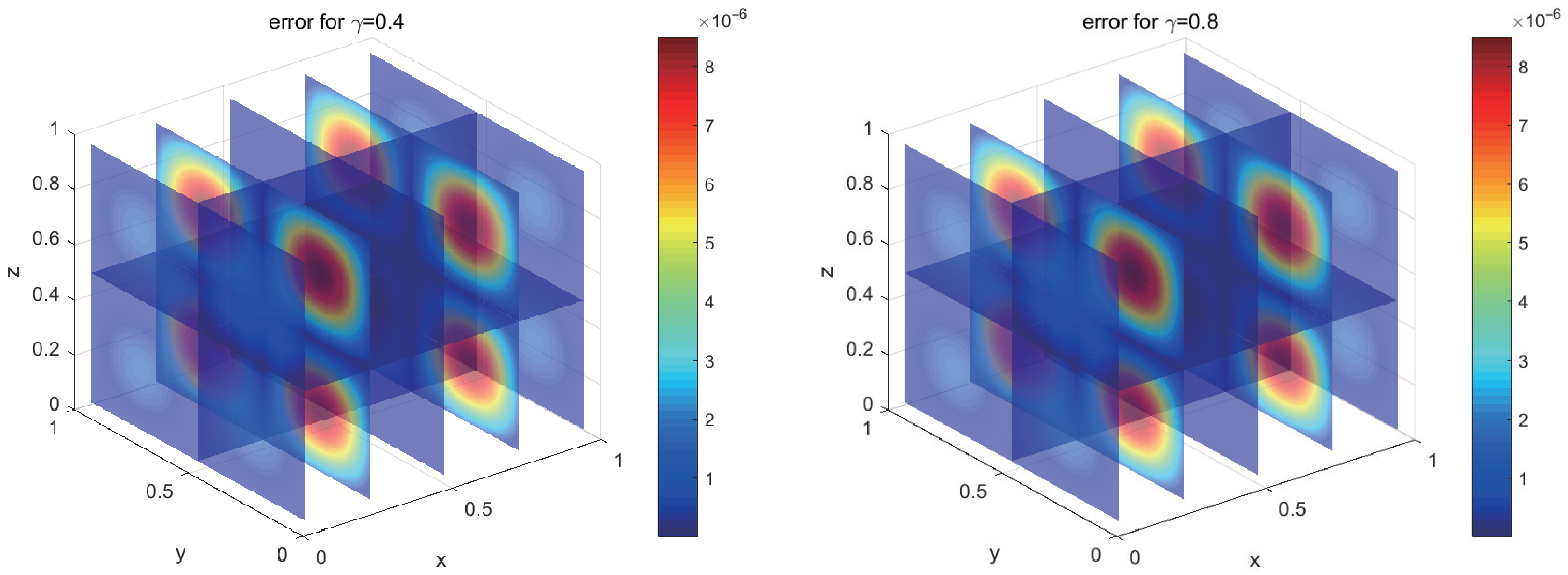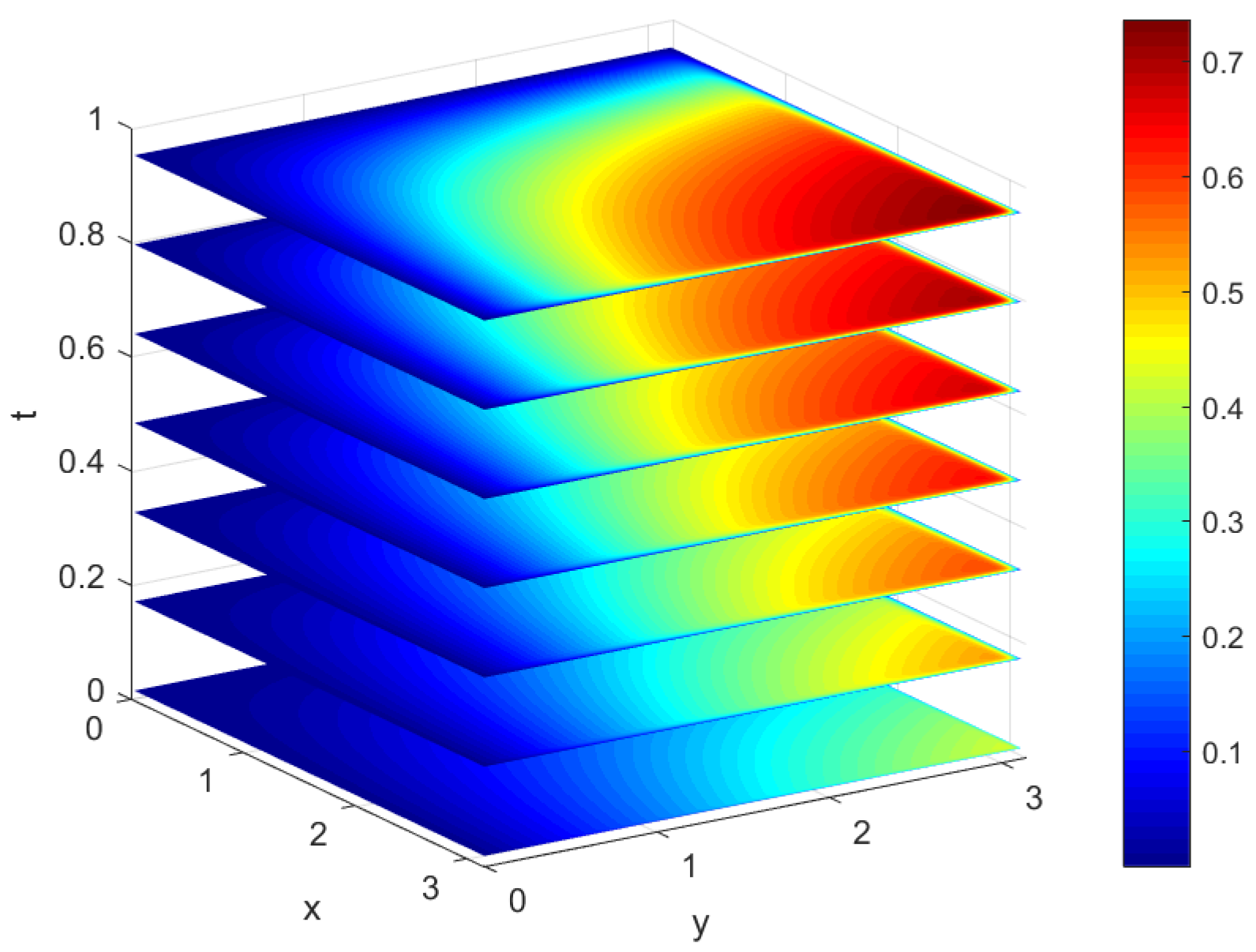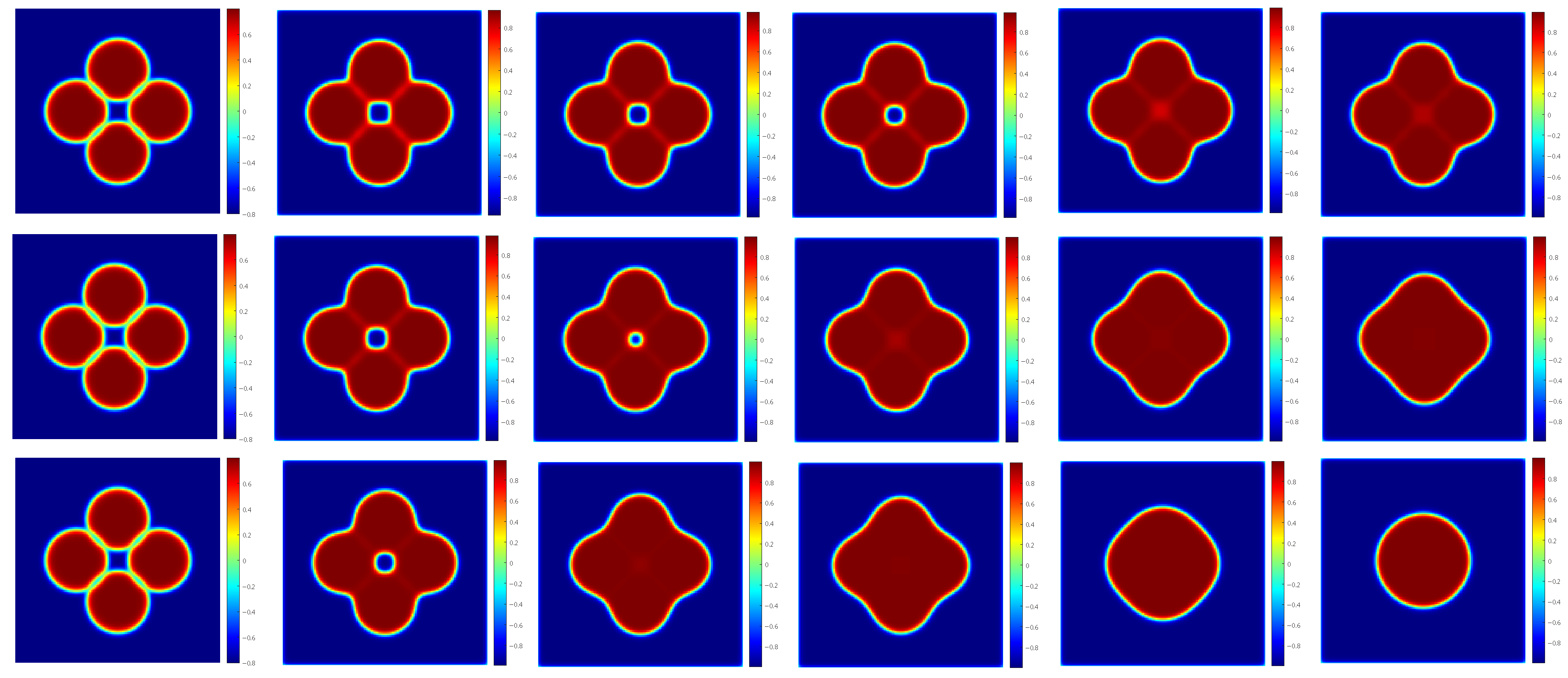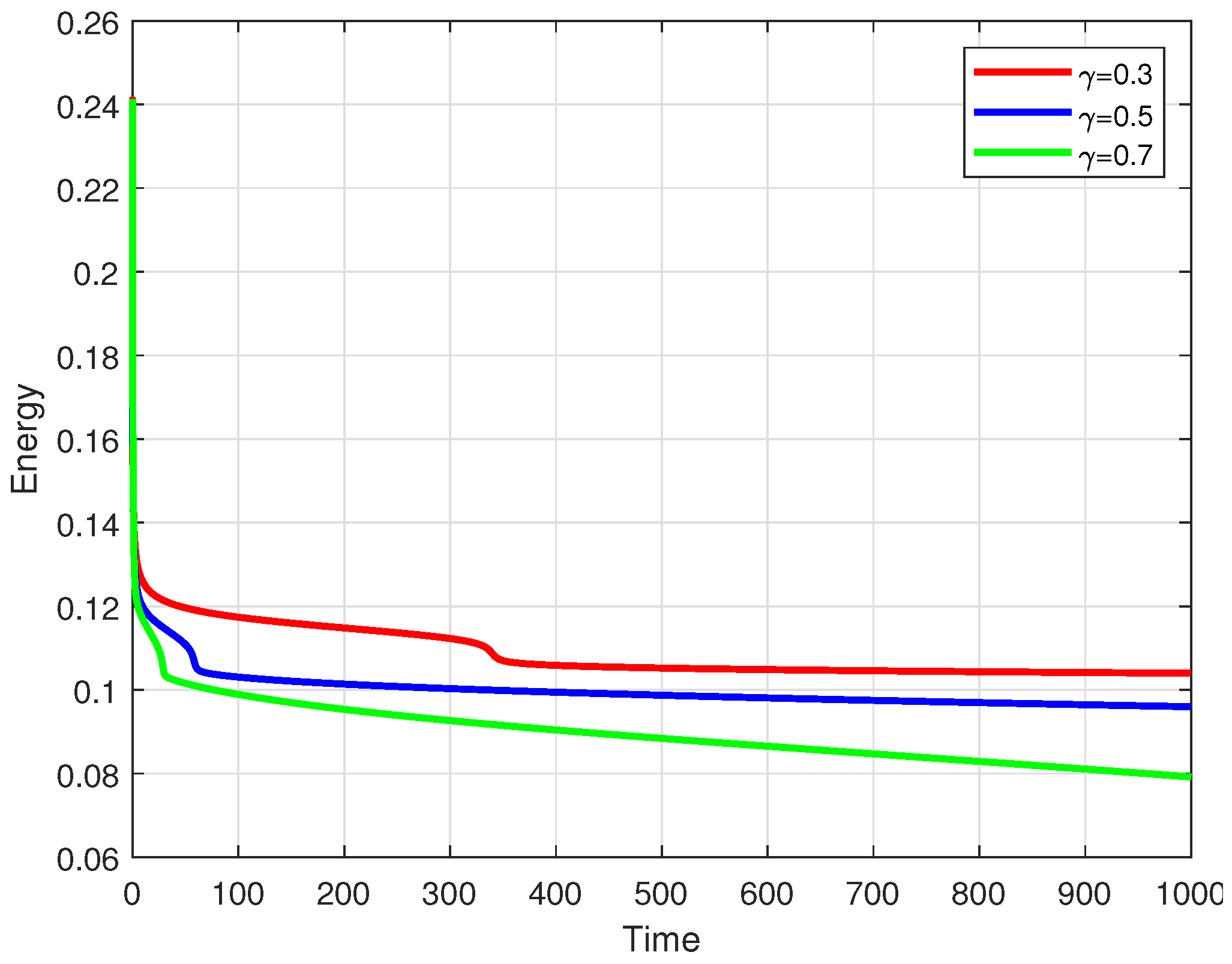1. Introduction
The stability and convergence analysis of the high-order accurate numerical method for high-dimensional time-fractional diffusion equations (TFDEs), presented in this paper, holds significant intrinsic value and provides a crucial foundation for solving numerous other high-dimensional fractional partial differential equations (PDEs). The model equation controls the evolution of the probability density function that describes the anomalous diffusing particles. Anomalous diffusion deviates from the Fisher standard description of Brownian, whose main characteristic is a nonlinear increase of the mean squared displacement with respect to time, such as
. The TFDE describes the anomalous sub-diffusion corresponding to
. Examples of sub-diffusive transport include turbulence and disordered dynamical carrier transport in amorphous semiconductors [
1], NMR diffusometry in disordered materials [
2], etc.
In recent years, fractional calculus has been widely applied to solve numerous scientific and engineering problems, including those in electromagnetics, physical sciences, diffusion, electrochemistry, and general transport theory. Many complex scientific and engineering problems are described more accurately and realistically by fractional-order PDEs than by integer-order PDEs, such as the synchronization of fractional order stochastic systems in finite-dimensional space [
3], fractional-order learning [
4], and the dynamic behavior of the hepatitis B-virus by the Caputo–Fabrizio fractional derivative [
5] with the definition
. Many effective schemes have been developed to solve linear and nonlinear TFDEs, such as the spectral method [
6], shifted Grünwald difference operator [
7], Gaussian radial basis functions method [
8], the L1-type scheme [
9,
10,
11,
12,
13], the L2-type scheme [
14,
15], etc.
We are interested in the following high-dimensional TFDEs:
where
with
is the dimension of the space.
is bounded,
T is a bounded positive constant, the boundary of
is
, and
denotes the closure of
. The
order Caputo fractional derivative
[
16] is defined as follows:
Additionally, the Euler gamma function is represented as
, the diffusion constants are expressed as
, and the known smooth functions are represented as
,
. For clarity, in the following numerical analysis, we assume that Equation (
1) has a unique and sufficiently smooth solution.
Considering the non-locality of fractional derivatives, the computational complexity of the numerical schemes for fractional derivatives is generally enormous. Therefore, constructing high-precision numerical schemes for fractional derivatives is a common approach to solving TFDEs. Due to the high-precision convergence of compact difference schemes (CFDs), such schemes are widely applicable in solving TFDEs by combining high-order temporal numerical methods. In [
17], a fourth-order compact ADI scheme was constructed to solve a two-dimensional, time-fractional, reaction-subdiffusion equation. In [
18], an efficient numerical scheme for the distributed order TFDE was developed by using the temporal L1 formula. In [
19], a variable-step second-order weighted ADI scheme was used to solve the 2D time-fractional telegraph equation. In [
20], two fast solvers were developed using time-marching and divide-and-conquer techniques. In [
21], an L2-type temporal scheme was used, but with a low-order accuracy at the first time level, to solve the TFDE. In [
22], a spatial sixth-order scheme was implemented to solve the TFDE with a temporal Caputo–Fabrizio fractional derivative. In [
23], a fast high-order scheme for a fractal mobile/immobile transport model was presented with an FFT and a CFD scheme. In [
24], a fourth-order compact ADI scheme was developed by applying the Padé approximation. In [
25], a high-order two-grid scheme for nonlinear PDEs was proposed, and the high-order mapping operator method was employed. In [
26], a CFD scheme was constructed to solve a time-fractional, fourth-order, integro-differential equation. In [
27], a high-order CFD method was proposed to solve linear time-fractional subdiffusion equations using an L2-type scheme. In [
28], a semilinear fractional initial-boundary value problem was solved and investigated using an L2-type time scheme.
However, the numerical schemes mentioned above are uniform temporal schemes designed for TFDEs with a smooth solution. In [
29], the L1 method on a graded mesh was applied to solve the multi-term TFDEs with weak singularity by using a weak Galerkin finite element method in space. In [
30], the authors introduced fast preconditioned iterative solvers for an all-at-once linear system based on Volterra sub-diffusion equations, employing a graded-step L1 scheme in time. In [
31], a robust ADI scheme on a graded mesh was proposed for solving sub-diffusion problems in 3D using an L1-type scheme in time. In [
32], a fast modified
scheme was used to address the initial weakly singular solution of the TFDE. In [
33], the initial singularity solution of the 2D time-fractional mobile/immobile diffusion problem was solved using the average L1-type scheme. In [
34], a numerical scheme with nonuniform time steps for distributed order sub-diffusion equations related to the initial weakly singular solution was presented in the form of an L1-type scheme.
Several shortcomings exist in the current L2-type scheme. The existing numerical schemes can be divided into two main categories. The first type approximates the first time level using a low-order numerical scheme, which can disrupt the consistent convergence order of time in theoretical analysis. The second type focuses on exact solutions when the equation has a special form, such as when the right-hand term does not contain unknown variables, which cannot be applied to semi-nonlinear problems. In addition, the exiting CFD schemes for 2D and 3D TFDEs mainly use ADI schemes, which reduce time accuracy to improve computational efficiency. The idea of constructing the above scheme is not applicable to constructing a high-precision numerical scheme for high-dimensional TFDEs. Therefore, in this work, we construct an improved high-order uniform temporal accuracy scheme using a coupled numerical scheme in the first and second layers to enhance the convergence accuracy and avoid restrictions on the right-hand term. The first advantage of the numerical scheme of this article can be applied directly to solving nonlinear problems, as it benefits from its form without relying on the right-hand function. The second advantage is that the computational complexity of the numerical scheme presented in this paper is lower than that of existing numerical schemes when the accuracy of solving the problem is determined. According to the emerging literature, there are few studies on the SFCD scheme for 3D TFDEs. Therefore, this article provides a detailed convergence and stability analysis of the CFD scheme for high-dimensional TFDEs with high uniform temporal accuracy.
This paper is a continuation of the research in [
35], in which detailed stability and convergence analysis are provided for a one-dimensional TFDE. In this paper, we provide a systematic theoretical analysis of the high-order numerical scheme for
d-dimensional TFDEs (
). The main strategies and innovations of this paper are as follows:
A high-order accurate implicit difference scheme for high-dimensional TFDEs is developed by combining a spatial fourth-order CFD schemes with an improved temporal L2 scheme.
The convergence of the improved numerical scheme for solving Equation (
1) is established by introducing an appropriate parameter transformation to rewrite an equivalent form and using the convergence of the geometric progression.
The improved numerical scheme ensures that the theoretical convergence accuracy at every time step is without requiring additional processing techniques. This numerical scheme can be easily extended to solve semi-linear TFDEs like the time-fractional Allen–Cahn equation.
The equivalence proof of the norm in the d-dimension and the standard -norm is rigorously established, which is convenient for analyzing the stability and convergence analysis of the proposed method applied to d-dimensional TFDEs.
The remainder of this article is organized as follows. In
Section 2, we present an improved high-order temporal accuracy scheme that incorporates the SCFD scheme for high-dimensional TFDEs. In
Section 3, we provide detailed proofs for the stability and convergence analysis of the improved fully discrete scheme with spatial and temporal high-order accuracy. Some numerical results of the improved scheme are presented to solve TFDEs with smooth and non-smooth solutions in
Section 4. In
Section 5, we provide a short summary.
2. An Improved Fully Discrete High-Order Uniform Temporal Accuracy Scheme
In this section, we construct a high-order temporal accuracy scheme with the SCFD approximation and perform a theoretical analysis of high-dimensional TFDEs (
1). For convenience, we refer mainly to the symbol representation in [
36]. Assume that
and
K are
positive integers and that the spatial grid size and temporal step-size are set as
. The spatial and temporal discrete points are defined as
,
.
For , we define and and . For simplicity, we set a multi-index and denote , grid function , and exact function by and .
Based on the idea of the definition in [
37], we define the compact difference operators
in the
directions, defined as follows:
where
I is the identical operator.
The discrete
semi-norm and
norm in
d-dimensional space of the grid function
u are given as
In this paper, instead of using the above standard
norm, we prefer to define the inner products and
norm as follows:
where
. It is easy to prove that
,
are all inner products, and the corresponding norms as defined above.
Next, we prove that the
norm in the
d-dimension is equivalent to the standard
norm, which is convenient for analyzing stability and convergence analysis. The author remarked that this proof is different from [
37] (Lemma 3.2). Consider that the proof in [
37] can only be generalized to the
d-dimensional case when
. Therefore, this article provides a different proof for the
d-dimensional case with
in the following Lemma 1.
Lemma 1. For any grid function , the following inequality holds:where . Proof. Using the inverse estimate
, we have
Combining (
3) and (
4), we obtain
Repeated the idea of inequality (
5) gives the following inequality:
Next, we estimate
. More precisely,
Using the right-hand side of (
6), we have
According to
, it is easy to obtain
On the other hand, using the inverse estimate and the left-hand side of (
6), we obtain
Along the proof of [
37] (Lemma 3.1), we get
Substituting (
9) into (
8), we obtain
Combining (
7) and (
10), we have proved Lemma 1. □
In the following Lemmas 2–5, these are the preliminaries of stability analysis and convergence analysis. In order to enhance readability, we list these lemmas below. For the compact difference operator, we have the following property.
Lemma 2 ([38]).Suppose that and , thenwhere Similar to [
14,
35], for simplicity in the numerical scheme, we set
and develop an improved high-order approximation to discretize
as follows:
where
and the coefficients of (
12) are given in [
35].
Similar to the proofs in [
14,
35], the error estimate of the high-order approximation to the fractional derivative (
12) can be easily obtained as follows:
where
and
is a positive constant independent of
.
By substituting the points
into Equation (
1) 1st row, we obtain the following equation:
Applying the high-dimensional SCFD operator
to both sides of Equation (
14), the spatial semi-discretized form is immediately established for TFDEs as follows:
Suppose
. Using Lemma 2 and (
13), the fully discretized scheme for Equation (
1) can be obtained immediately:
and
satisfies the following expression:
where
is the
i-th orthonormal basis.
satisfies the following conditions:
where
is a positive constant that is independent of
.
For conciseness, we introduce the high-dimensional CFD as follows:
Considering that
, when
and
,
can be ignored in (
15), but using (
17) and the high-order numerical scheme for Equation (
1) 1st row, it can be obtained as follows:
To establish error estimates for the fully discretized scheme (
18), we rewrite it for
in the following equivalent form:
where the coefficients
satisfy the following equation:
Similarly, for
, we obtain the following equation:
where
Combining (
19) and (
20), the equivalent form of Equation (
18) is as follows:
In order to establish the error estimates of (
21), we present the properties of
of (
21) as the following Lemma 3.
Lemma 3 ([15,
35]).For , then the coefficients of (21) satisfy - (1)
- (2)
- (3)
- (4)
- (5)
can be either positive or negative;
- (6)
Lemma 3 implies that the symbol of the coefficient
remains uncertain for
. Therefore, it would be very difficult to analyze the error estimates of our proposed numerical scheme by applying the direct analysis method. Consequently, a suitable technique is adopted for the error estimates of our proposed scheme for
. More precisely, an improved analytical method is used for the error estimates of the scheme (
21). For
, we introduce the parameter
and rewrite Equation (
21) 4th row as follows:
For the sake of conciseness, let us denote
Using the new notation mentioned above, the numerical scheme can be rewritten in an equivalent form:
Based on (
22)–(
24), Equation (
21) 4th row can be rewritten as follows:
For
, similar to (
25), Equation (
21) 3rd row can also be rewritten as follows:
By combining Equations (
25) and (
26), we obtain an equivalent form of the scheme (
21) as follows:
On the basis of the proofs presented in [
14,
15], it can be immediately proven that the coefficients of Equation (
27) 4th row satisfy the following lemmas.
Lemma 4 ([35]).For and , the coefficients of Equation (27) 4th row satisfy: - (1)
- (2)
- (3)
.
Because
, Equation (
27) 3rd and 4th row can now write a unified form, where:
Lemma 5 ([35]).For , , then Equation (27) 3rd row’s coefficients have following properties - (1)
;
- (2)
;
- (3)
.
Lemma 6 ([35]). and , the coefficient satisfywhere is defined by (1) in Lemma 3. 3. Error Estimates
Without loss of generality for the stability analysis, set
. Based on the proof of the one-dimensional CFD in [
35], Lemma 7 can be proven by adding additional spatial variables. Similarly, Lemma 8 can be proven using Lemma 7 with
norm and
discrete inner product. However, in order to ensure the readability of the article and consider that the definition and estimations of the spatial norm are more complex than one-dimensional problems due to the increase in spatial dimensions, we provide a detailed proof.
Lemma 7. For any grid function and on , it holds that Proof. First of all, by direct calculation one can obtain
For
, by using the definition of the SCFD and direct calculation, we can obtain
By using (
2), the proof is then completed. □
Lemma 8. Letand we havewhere β satisfies Proof. Let us multiply
in Equation (
27) 1st row and
in Equation (
27) 2nd row by summing over
. Adding them and according to Lemma 7, based on the idea of [
35] (Lemma 3.1), we have
Due to
, we have
. Therefore,
. From (
31), it can be concluded that
According to
, we have
Using the inequality estimation results mentioned above, we get
According to the definition of
in (
30), we have completed (
29) for
. Lemma 8 is then completed. □
Next, we will give the estimate of for as follows.
Lemma 9. We havewhere β is defined in (30). Proof. First, by using (23) we obtain the following identity:
Next, for
, multiplying
in Equation (
27) 3rd row, summing the variable
, we obtain the following:
By using the properties of discrete inner product and performing simple calculations, it can be concluded that
According to Lemma 7, substituting (
33) into (
34), we obtain
According to (1) in Lemma 5, it is known that
and
; (
35) becomes
According to (3) in Lemma 5, one can obtain
. Therefore, the above inequality can be transformed into the following inequality:
Due to
, (
36) can be changed to
According to (2) in Lemma 5, we can get
. Based on the properties of
, the inequality (
37) can be rewritten as follows:
According to (3) in Lemma 5 and Lemma 8, we have
For
, by multiplying
in Equation (
27) 4th row and summing over
, we have the following equality:
By using the properties of discrete inner product, we can conclude that
Using the equivalence of the discrete inner product and the discrete norm, (
33) and (3) in Lemma 4, we have
Adding some positive terms
on the right, ignoring the positive term
on the left, and arranging the above inequality in a similar form on both sides, one can obtain
One can quickly verify the following inequality through the mathematical induction:
For
, according to (
29), (
38), (
39), and (3) in Lemma 4, we then have
In (
41), (
40) has been proven for
. Assuming (
40) holds for
, one can promptly obtain that
Therefore, (
40) has been proven by mathematical induction. Lemma 9 is established through rigorous derivation. □
At this stage, we will analyze the stability of the improved numerical scheme with spatial and temporal high-order accuracy in the following Theorem 1.
Theorem 1. The numerical solution of (27) with satisfiesfor all . Proof. With the help of Lemmas 8 and 9, one can immediately get the result
Considering
, ignoring
on the left and taking the square root of the two sides of (
42), one can obtain that
Next, we will use the above inequality to estimate
. Using (23), we obtain
In the above inequality derivation, we use the triangle inequality of the norm, repeatedly replacing the right side of the inequality with for and .
Simplifying the above inequality, we get
Again using (
42) and
, we can get
Combining (
43) and (
44), we obtain
Hence, the proof of Theorem 1 is completed. □
Let us define the error as follows:
We will analyze the convergence order of (
27) in the following result.
Theorem 2. Let be defined by (1) and be defined by (27). If , thenwhere and the expression of C is as follows,where is defined in (16) and are defined as follows: Proof. By (
15), (
16), (
18), and (
21),
satisfies the following equations:
where
for
Next, we will use (
48) to prove (
45) in three parts.
- (i)
First of all, we shall prove
where
is defined by (
11) and
are defined by (
47).
Multiplying
in Equation (
48) 1st row and
in Equation (
48) 2nd row by summing over
and adding them taking into account
, we have
According to Lemma 7, Equation (
51) can be rewritten as
Because
and
are all positive numbers depending on
, we have
Because
are all positive, according to (
47) we know that
,
.
According to the definition of
, we know that
and
. From (
53), we can immediately obtain that
According to
, we have
Using the similar method for
, we get
Therefore, combining (
54) and (
55), we have already proven (49) and (50).
- (ii)
We will prove the following inequality:
First of all, according to (49) and (50), one can obtain that (
56) is true for
.
Next, for
, using (23) and the similar proof of (
33), we can obtain
Multiplying
on Equation (
48) 3rd row and summing over
, we have
Using the properties of discrete inner product, (
57), and Lemma 5, we have
Arranging the above inequality, we can get the following result:
According to (2) in Lemma 5, we know
, so we have
According to (49), (50), and Lemma 6, we have
Therefore, (
56) is true for
.
For
, multiplying
in Equation (
48) 4th row and summing over
, we have
Using the properties of discrete inner product, we have
Using the equivalence of the discrete inner product, norm, Lemma 4, and (
57), we have
Adding some positive terms
on the right, ignoring the positive term
on the left, and arranging the above inequality in a similar form on both sides, one can obtain that
Next, we will use mathematical induction to prove (
56) for
.
For
, using (
58) we can obtain
Based on (3) in Lemma 4, it is known that
. Hence, the inequality (
56) is correct for
.
Next, assuming that (
56) is true for
, one can immediately have
Therefore, (
56) is correct for
.
- (iii)
Finally, we will prove the following:
where
C is defined in (
46).
From (
56) and (
16), we can obtain the following:
where
C is defined by (
46).
Theorem 2 has been proven. □










